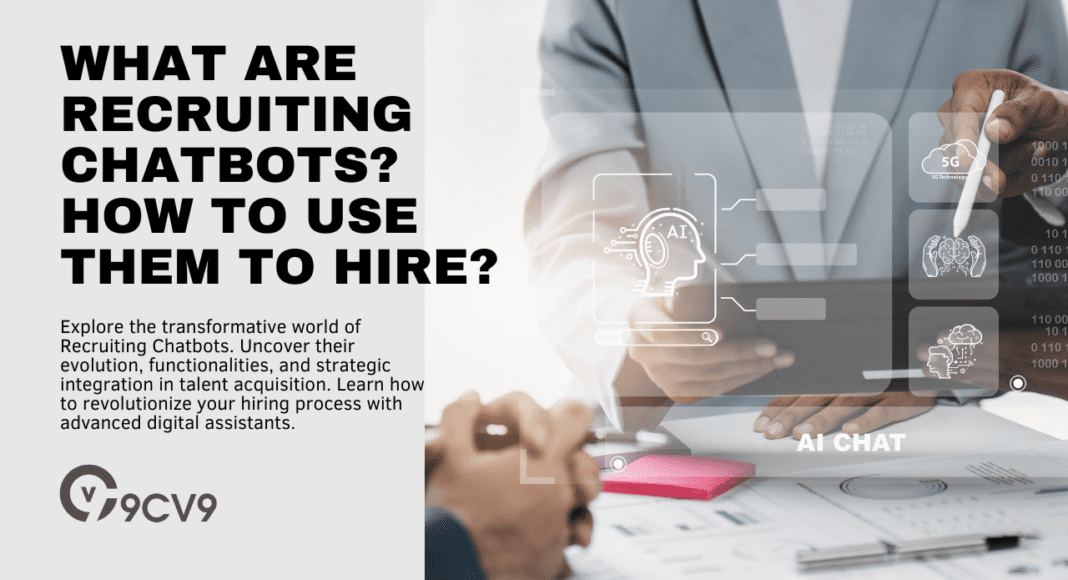Key Takeaways
- Efficiency Amplified: Discover how Recruiting Chatbots streamline hiring processes, automating tasks from resume screening to interview scheduling for unprecedented efficiency.
- Elevated Candidate Experience: Explore the impact of chatbots on candidate interactions, offering a personalized journey that redefines traditional recruitment experiences.
- Future-Ready Strategies: Learn key insights for strategic integration, overcoming challenges, and embracing future trends in adopting Recruiting Chatbots for a competitive edge in talent acquisition.
In the ever-evolving landscape of human resources and talent acquisition, the integration of cutting-edge technologies has become not just a choice but a necessity.
One such innovation that has taken the recruitment world by storm is the advent of Recruiting Chatbots.
These sophisticated virtual assistants are not merely lines of code; they represent a paradigm shift in how organizations discover, engage, and hire top-tier talent.
Unveiling the Future of Hiring
Picture a scenario where the recruitment process is not just efficient but also personalized, where candidates experience a seamless journey from application to onboarding.
This is precisely the promise that Recruiting Chatbots hold.
As we delve into this transformative technology, it becomes imperative to understand not only what these chatbots are but, more importantly, how organizations can harness their potential to revolutionize the hiring process.
Defining Recruiting Chatbots: Beyond the Binary
Recruiting Chatbots, at their core, are AI-powered virtual assistants designed to interact with candidates and streamline various aspects of the recruitment process.
But they are more than just lines of code executing predefined tasks.
These intelligent entities leverage Natural Language Processing (NLP) and machine learning algorithms to engage in dynamic, context-aware conversations with job seekers.
They transcend the limitations of traditional recruiting methods, providing a personalized and responsive interface that adapts to the unique needs of each candidate.
The Evolutionary Journey of Chatbots in Recruitment
To truly appreciate the impact of recruiting chatbots, it’s essential to trace their evolutionary journey.
From their humble beginnings as basic rule-based systems to the sophisticated conversational agents of today, these chatbots have undergone a remarkable transformation.
They have shifted from being mere tools for automating repetitive tasks to becoming strategic partners in the talent acquisition process.
Unraveling the Tapestry of Benefits
The benefits of incorporating recruiting chatbots into the hiring ecosystem are manifold.
Efficiency is a cornerstone, as these digital assistants significantly reduce the time and effort invested in repetitive administrative tasks.
Imagine a scenario where screening resumes, scheduling interviews, and answering candidate queries happen in real-time, allowing HR professionals to focus on strategic, value-driven aspects of recruitment.
Beyond efficiency, candidate experience takes center stage.
Personalization, often elusive in traditional recruitment processes, becomes a hallmark of the chatbot interaction.
Candidates are guided through the application process with a human touch, addressing queries, providing insights, and ensuring a positive and engaging experience.
Navigating the Implementation Landscape
As organizations contemplate the integration of recruiting chatbots, questions inevitably arise: How does one choose the right chatbot platform?
What does the implementation process entail, and how can these virtual assistants be seamlessly integrated into existing HR systems?
The journey from contemplation to implementation is a pivotal phase, and understanding the nuances is key to unlocking the full potential of this transformative technology.
In the subsequent sections of this comprehensive guide, we will delve into the intricacies of implementing recruiting chatbots, exploring best practices, real-world examples, and the future trends that promise to shape the landscape of talent acquisition.
Embark with us on this enlightening journey as we demystify the realm of recruiting chatbots, unravel their potential, and guide organizations on how to leverage them effectively to not just hire, but to elevate the entire recruitment experience.
Welcome to the future of hiring, where innovation meets interaction, and talent acquisition transcends boundaries.
Before we venture further into this article, we like to share who we are and what we do.
About 9cv9
9cv9 is a business tech startup based in Singapore and Asia with a strong presence all over the world.
With over eight years of startup and business experience, and being highly involved in connecting with thousands of companies and startups, the 9cv9 team has listed some important learning points in this overview of What are Recruiting Chatbots.
If your company needs recruitment and headhunting services to hire top SEO employees, you can use 9cv9 headhunting and recruitment services to hire top talents and candidates. Find out more here, or send over an email to [email protected].
Or just post 1 free job posting here at 9cv9 Hiring Portal in under 10 minutes.
What are Recruiting Chatbots? How to Use Them To Hire?
- Understanding Recruiting Chatbots
- Benefits of Using Recruiting Chatbots
- How to Implement Recruiting Chatbots
- Best Practices for Utilizing Recruiting Chatbots
- Overcoming Challenges in Adopting Recruiting Chatbots
- Future Trends and Innovations in Recruiting Chatbots
1. Understanding Recruiting Chatbots: Decoding the Digital Assistants of Talent Acquisition
In the dynamic realm of modern recruitment, understanding the intricacies of Recruiting Chatbots is pivotal.
These AI-driven digital assistants go beyond the surface, leveraging advanced technologies to redefine how organizations connect with and hire top talent.

Defining Recruiting Chatbots: The Essence of Virtual Assistants
- Purpose and Functionality:
- Recruiting Chatbots are AI-powered virtual assistants designed to streamline and enhance various aspects of the hiring process.
- Their primary purpose is to engage with candidates, providing a personalized and efficient interaction.
- Natural Language Processing (NLP):
- Integral to chatbots is Natural Language Processing, enabling them to understand and respond to human language nuances.
- This technology allows for dynamic, context-aware conversations, mimicking human-like interactions.
Evolutionary Journey: From Rule-Based Systems to Conversational Agents
- Origins and Early Functionality:
- Chatbots have evolved from basic rule-based systems that followed predefined scripts.
- Early implementations focused on automating repetitive tasks in recruitment, such as initial screening.
- Shift to Conversational Agents:
- Modern Recruiting Chatbots have transcended their initial role, becoming conversational agents capable of adaptive, real-time interactions.
- They employ machine learning algorithms to continuously improve their understanding and response capabilities.
Key Features and Capabilities: Unveiling the Arsenal of Chatbots
- Dynamic Interaction:
- Chatbots engage candidates in dynamic conversations, guiding them through the application process.
- This dynamic interaction adapts to individual candidate needs, providing a personalized experience.
- Automated Screening:
- They excel in automating the initial stages of candidate screening by parsing resumes and assessing basic qualifications.
- This feature expedites the screening process, allowing recruiters to focus on more strategic aspects.
Benefits of Implementing Recruiting Chatbots: A Multifaceted Advantage
- Efficiency and Time Savings:
- Streamlining administrative tasks, chatbots significantly reduce the time and effort invested in the hiring process.
- Automated scheduling, resume screening, and FAQ responses contribute to overall efficiency gains.
- Enhanced Candidate Experience:
- Personalized interactions create a positive candidate experience, fostering engagement and brand perception.
- Chatbots address candidate queries promptly, providing a human-like touch in the digital recruitment journey.
Real-world Examples: Showcasing Success Stories
- IBM’s Watson Recruitment Assistant:
- IBM’s Watson Recruitment Assistant is a prime example of a chatbot revolutionizing the hiring process.
- It employs NLP to understand candidate queries, assists in job searches, and even recommends suitable positions.
- Olivia by Paradox Interactive:
- Olivia is a chatbot developed by Paradox Interactive, known for its conversational abilities.
- It engages candidates in natural language conversations, handling tasks from application to onboarding.
Challenges and Considerations: Navigating the Implementation Landscape
- Integration Complexity:
- Organizations may face challenges integrating chatbots with existing HR systems and workflows.
- Choosing a platform that aligns with organizational needs is crucial for seamless implementation.
- Privacy and Compliance:
- Ensuring compliance with data protection regulations is paramount when dealing with candidate information.
- Organizations must implement robust security measures to safeguard sensitive data.
The Future of Recruiting Chatbots: Anticipating Trends and Innovations
- Advanced AI Capabilities:
- Future chatbots are expected to possess even more advanced AI capabilities, enhancing their understanding and decision-making abilities.
- Integration with predictive analytics may enable chatbots to forecast candidate success in specific roles.
- Multi-Channel Engagement:
- Anticipate the evolution of chatbots beyond traditional web interfaces to diverse communication channels.
- Integration with messaging apps and social media platforms may become standard, expanding reach and accessibility.
In comprehending the essence of Recruiting Chatbots, organizations gain not just a technological tool but a strategic partner in the quest for exceptional talent.
The journey involves understanding their evolution, leveraging their key features, and navigating potential challenges.
2. Benefits of Using Recruiting Chatbots: Transforming Talent Acquisition
Recruiting Chatbots have emerged as indispensable tools in modern talent acquisition, offering a plethora of benefits that extend beyond efficiency gains.
Understanding these advantages is crucial for organizations looking to elevate their hiring processes to new heights.
Efficiency Redefined: Streamlining Administrative Tasks
- Automated Resume Screening:
- Chatbots excel in automating the initial stages of candidate screening by parsing resumes.
- This significantly reduces the time spent on manual reviews, allowing recruiters to focus on more strategic aspects.
- Efficient Scheduling:
- Chatbots streamline the scheduling process by coordinating interview times based on candidate availability.
- This eliminates the back-and-forth communication and accelerates the overall recruitment timeline.
Enhanced Candidate Experience: Personalization at its Core
- Dynamic Interactions:
- Chatbots engage candidates in dynamic and context-aware conversations, providing a personalized experience.
- Tailored interactions create a positive impression, enhancing the overall candidate journey.
- Real-time Assistance:
- Candidates receive instant responses to queries, improving their experience during the application and interview stages.
- This instant support fosters engagement and reflects positively on the employer brand.
Cost Reduction and Resource Optimization:
- Time-to-Hire Reduction:
- The efficiency gains achieved through chatbots contribute to a notable reduction in time-to-hire.
- Expedited processes mean organizations can secure top talent before competitors.
- Resource Allocation:
- By automating repetitive tasks, chatbots free up human resources to focus on strategic and value-driven aspects of recruitment.
- HR professionals can dedicate more time to building relationships and refining recruitment strategies.
24/7 Accessibility: Meeting Candidates Where They Are
- Round-the-Clock Engagement:
- Chatbots operate 24/7, providing candidates with accessibility outside traditional office hours.
- This flexibility accommodates diverse schedules and time zones, catering to a global talent pool.
- Multichannel Interaction:
- Integration with various communication channels, including messaging apps and social media, enhances accessibility.
- Candidates can engage with chatbots through platforms they are most comfortable with.
Data-Driven Decision Making: Insights for Strategic Recruitment
- Analytics and Reporting:
- Chatbots generate valuable data on candidate interactions, providing insights into user behavior and preferences.
- Analytics empower recruiters to make data-driven decisions, optimizing recruitment strategies for better results.
- Continuous Improvement:
- Machine learning capabilities allow chatbots to learn and adapt over time.
- Continuous improvement based on data analysis ensures that chatbots evolve to meet changing recruitment needs.
In harnessing the benefits of recruiting chatbots, organizations position themselves at the forefront of innovation in talent acquisition.
The efficiency gains, enhanced candidate experience, and strategic insights derived from these digital assistants contribute to a transformative recruitment process.
3. How to Implement Recruiting Chatbots: A Comprehensive Guide to Seamless Integration
Implementing Recruiting Chatbots is a strategic move that requires careful planning and execution.
From choosing the right platform to seamless integration with existing HR systems, organizations can unlock the full potential of these digital assistants with a well-thought-out implementation strategy.
Selecting the Right Chatbot Platform: Key Considerations
- Define Objectives and Requirements:
- Clearly outline the objectives of integrating chatbots into the recruitment process.
- Identify specific requirements such as automated screening, candidate engagement, or interview scheduling.
- Scalability and Customization:
- Choose a platform that is scalable and can adapt to the growing needs of the organization.
- Look for customization options to tailor the chatbot to specific industry requirements or company branding.
- Integration with Existing Systems:
- Ensure compatibility with existing HR systems, applicant tracking systems (ATS), and other relevant tools.
- Seamless integration minimizes disruptions and facilitates a cohesive recruitment ecosystem.
Integration Process: From Planning to Execution
- Needs Assessment and Planning:
- Conduct a thorough needs assessment to identify pain points in the current recruitment process.
- Develop a detailed plan outlining how chatbots will address these challenges and enhance efficiency.
- Collaboration with IT and HR Teams:
- Foster collaboration between the IT and HR teams to ensure a smooth integration process.
- IT teams can provide insights into technical requirements, while HR teams contribute domain-specific expertise.
- Data Migration and Security Measures:
- Implement robust data migration processes to transfer relevant information to the chatbot platform.
- Prioritize data security measures to safeguard sensitive candidate information.
Customization for Specific Hiring Needs: Tailoring the Chatbot Experience
- Designing User-Friendly Interfaces:
- Ensure that the chatbot interface is user-friendly, providing a seamless experience for both candidates and recruiters.
- Intuitive design contributes to higher engagement and overall satisfaction.
- Natural Language Processing (NLP) Integration:
- Leverage NLP capabilities to enhance the chatbot’s understanding of natural language queries.
- Fine-tune NLP models to align with the specific terminology and nuances of the industry.
- Personalization and Brand Alignment:
- Customize the chatbot’s interactions to reflect the organization’s brand voice and values.
- Implement personalization features to make candidate interactions more relevant and engaging.
Training and Onboarding: Ensuring Smooth Implementation
- Training HR Teams and Recruiters:
- Provide comprehensive training for HR teams and recruiters to effectively utilize chatbot capabilities.
- Familiarize them with the chatbot’s features, functionalities, and potential use cases in the recruitment workflow.
- Onboarding Candidates:
- Develop onboarding materials and resources to guide candidates through the use of the chatbot.
- Clear communication on how the chatbot enhances their experience can contribute to positive adoption.
Continuous Monitoring and Optimization: Maximizing Effectiveness
- Performance Metrics and Analytics:
- Define key performance indicators (KPIs) to measure the effectiveness of the chatbot implementation.
- Regularly monitor analytics related to candidate engagement, time-to-hire, and other relevant metrics.
- User Feedback and Iterative Improvements:
- Encourage user feedback from both candidates and recruiters to identify areas for improvement.
- Implement iterative updates and improvements based on feedback to enhance the chatbot’s performance.
In navigating the implementation landscape of recruiting chatbots, organizations can position themselves for success by making informed decisions, fostering collaboration between teams, and prioritizing user experience.
4. Best Practices for Utilizing Recruiting Chatbots: Elevating the Candidate Experience
Incorporating Recruiting Chatbots into the talent acquisition process requires a strategic approach to ensure optimal performance and a positive impact on the candidate journey.
These best practices encompass design, functionality, and ongoing optimization, providing a roadmap for organizations to maximize the potential of chatbots.
Designing a User-Friendly and Engaging Interface
- Intuitive Navigation:
- Prioritize a user-friendly design with intuitive navigation to enhance the candidate experience.
- Ensure that candidates can easily access information and perform tasks through the chatbot interface.
- Clear Call-to-Action (CTA):
- Implement clear and concise CTAs to guide candidates through the recruitment process.
- CTAs should be strategically placed to prompt desired actions, such as submitting resumes or scheduling interviews.
- Visual Elements:
- Incorporate visual elements, such as buttons and images, to make interactions more engaging.
- Visual cues can aid in guiding candidates and simplifying complex information.
Incorporating Natural Language Processing (NLP) for Effective Communication
- Natural Language Understanding:
- Leverage advanced NLP capabilities to enhance the chatbot’s understanding of diverse language patterns.
- Train the chatbot to interpret colloquial language and industry-specific terminology.
- Context-Aware Conversations:
- Ensure that the chatbot can maintain context throughout conversations for a more personalized experience.
- Context-aware interactions contribute to a seamless and human-like engagement.
- Multilingual Support:
- If applicable, implement multilingual support to cater to a diverse pool of candidates.
- This feature enhances accessibility and inclusivity in recruitment interactions.
Ensuring Compliance with Privacy and Data Security Regulations
- Data Encryption:
- Implement robust data encryption measures to secure sensitive candidate information.
- Encryption ensures that data transmitted between the chatbot and servers remains confidential.
- GDPR and Data Handling:
- Adhere to General Data Protection Regulation (GDPR) guidelines and other data protection regulations.
- Clearly communicate to candidates how their data will be handled and stored by the chatbot.
Strategic Integration with Existing HR Systems and Tools
- Seamless ATS Integration:
- Ensure seamless integration with Applicant Tracking Systems (ATS) to centralize candidate data.
- This integration streamlines the recruitment workflow and avoids data silos.
- Compatibility with HR Software:
- Verify compatibility with other HR software and tools used by the organization.
- A cohesive integration ensures that the chatbot becomes an integral part of the broader HR technology stack.
Continuous Monitoring and Performance Improvement
- Key Performance Indicators (KPIs):
- Define and regularly monitor KPIs related to chatbot performance, candidate engagement, and time-to-hire.
- Metrics provide insights into the effectiveness of the chatbot in meeting recruitment goals.
- User Feedback Mechanism:
- Implement a mechanism for collecting user feedback from candidates and recruiters.
- Feedback loops facilitate continuous improvement and address any issues promptly.
Ethical and Inclusive Chatbot Design
- Bias Mitigation:
- Proactively address and mitigate biases that may arise in chatbot interactions.
- Regularly review and update algorithms to ensure fair and unbiased treatment of all candidates.
- Inclusive Language:
- Use inclusive language that reflects diversity and avoids reinforcing stereotypes.
- The chatbot should contribute to a positive and inclusive candidate experience for individuals from various backgrounds.
In embracing best practices for utilizing recruiting chatbots, organizations can create a seamless and engaging recruitment experience for candidates.
By focusing on design, communication, compliance, integration, and continuous improvement, chatbots become strategic allies in talent acquisition, contributing to efficiency gains and positive employer branding.
5. Overcoming Challenges in Adopting Recruiting Chatbots: Navigating the Implementation Landscape
The integration of Recruiting Chatbots, while promising transformative benefits, is not without its challenges.
Addressing these hurdles strategically is crucial for organizations seeking to harness the full potential of chatbots in the recruitment process.
Here’s a comprehensive guide on overcoming challenges and ensuring a seamless adoption.
Integration Complexity: Bridging the Gap with IT
- Collaboration Between HR and IT Teams:
- Foster strong collaboration between HR and IT teams to align technical requirements with recruitment needs.
- Clear communication ensures that both teams understand the nuances of the chatbot integration process.
- Technical Expertise:
- Provide training or access to resources that enhance the technical expertise of HR professionals involved in the integration.
- Understanding the technical aspects of chatbot implementation is crucial for effective collaboration.
Privacy and Compliance Concerns: Safeguarding Candidate Data
- Data Security Protocols:
- Implement robust data security protocols to address concerns related to candidate data privacy.
- Encryption, access controls, and regular security audits contribute to a secure chatbot environment.
- GDPR Compliance:
- Ensure compliance with GDPR and other relevant data protection regulations.
- Transparently communicate to candidates how their data will be handled, providing reassurance about privacy.
Candidate Trust and User Adoption: Building Confidence in Technology
- Transparent Communication:
- Communicate openly with candidates about the role of chatbots in the recruitment process.
- Transparency fosters trust and helps candidates feel more comfortable engaging with the technology.
- User-Friendly Interfaces:
- Prioritize the design of user-friendly interfaces that enhance the overall candidate experience.
- Intuitive interfaces contribute to positive user adoption, reducing resistance to interacting with chatbots.
Overcoming Bias and Fair Treatment: Ensuring Ethical AI Practices
- Algorithmic Fairness:
- Regularly assess and address biases that may inadvertently arise in chatbot interactions.
- Implement measures to ensure fair treatment of candidates from diverse backgrounds.
- Diverse Training Data:
- Use diverse training data to expose the chatbot to a wide range of scenarios and language patterns.
- Diversifying data helps the chatbot better understand and respond to the diverse pool of candidates.
Integration with Existing Workflows: Streamlining the Process
- ATS Compatibility:
- Ensure seamless integration with Applicant Tracking Systems (ATS) to avoid disruptions in existing workflows.
- Compatibility with ATS facilitates a streamlined recruitment process with centralized data management.
- Customization for Industry Specifics:
- Customize the chatbot to align with industry-specific terminology and nuances.
- A tailored approach ensures that the chatbot seamlessly integrates into the unique recruitment landscape of the organization.
Resistance to Change: Cultivating a Tech-Positive Culture
- Change Management Strategies:
- Implement effective change management strategies to address resistance among employees.
- Communicate the benefits of chatbot adoption and provide training to ease the transition.
- Showcasing Success Stories:
- Share success stories from early adopters within the organization.
- Real-world examples of positive outcomes can inspire confidence in the value of chatbots.
In overcoming challenges in adopting recruiting chatbots, organizations can position themselves for success by fostering collaboration, prioritizing data security, and addressing ethical considerations.
6. Future Trends and Innovations in Recruiting Chatbots: Paving the Way for Advanced Talent Acquisition
The landscape of recruiting chatbots is continuously evolving, driven by advancements in technology and a dynamic job market.
Exploring future trends and innovations provides organizations with insights into how they can stay at the forefront of talent acquisition.
Here’s an in-depth look into what the future holds for recruiting chatbots:
Advanced AI Capabilities: The Evolution Continues
- Predictive Analytics Integration:
- Future chatbots are expected to integrate predictive analytics for a more strategic approach to talent acquisition.
- Predictive models can forecast candidate success, enabling recruiters to make informed decisions.
- Enhanced Machine Learning Algorithms:
- The evolution of machine learning algorithms within chatbots will lead to enhanced understanding and decision-making capabilities.
- Continuous learning from data will contribute to more accurate candidate assessments.
Multi-Channel Engagement: Expanding Reach and Accessibility
- Integration with Messaging Apps:
- Chatbots will extend beyond traditional web interfaces, integrating seamlessly with popular messaging apps.
- This expansion enhances accessibility, meeting candidates where they are comfortable.
- Social Media Interaction:
- Future chatbots may actively engage candidates on social media platforms, providing information and support.
- Social media integration extends the reach of recruitment efforts and facilitates real-time interactions.
Conversational UX and Personalization: Redefining Candidate Interactions
- Conversational User Experience (UX) Enhancements:
- The future will see further refinements in conversational UX, making interactions with chatbots more natural and engaging.
- Improved language models and contextual understanding will contribute to a more fluid conversation.
- Hyper-Personalization Features:
- Chatbots will leverage hyper-personalization, tailoring interactions based on individual candidate preferences and career aspirations.
- Personalized recommendations and guidance will elevate the overall candidate experience.
Voice Recognition Technology: Shaping the Future of Interaction
- Voice-Activated Chatbots:
- The integration of voice recognition technology will enable voice-activated chatbots for hands-free interactions.
- Candidates can engage with chatbots using voice commands, enhancing accessibility and user experience.
- Natural Language Understanding in Voice Interactions:
- Advances in natural language understanding will ensure that voice interactions are as contextually rich as text-based interactions.
- Voice-activated chatbots will become more adept at understanding and responding to nuanced spoken language.
Automated Skill Assessment: Enhancing Pre-screening Processes
- AI-Driven Skill Evaluation:
- Future chatbots may incorporate advanced AI algorithms for automated skill assessment during candidate interactions.
- This feature streamlines the pre-screening process, helping recruiters identify top talents more efficiently.
- Interactive Skill Challenges:
- Chatbots may introduce interactive skill challenges to assess candidates in real-time.
- This innovative approach provides a more accurate representation of a candidate’s capabilities.
Virtual Reality (VR) and Augmented Reality (AR): Redefining Candidate Engagement
- VR-Based Job Previews:
- Virtual Reality can be integrated into chatbots to provide candidates with immersive job previews.
- Candidates can virtually experience a day in the life of a role, aiding in informed decision-making.
- AR for Virtual Interviews:
- Augmented Reality may enhance virtual interviews by providing interactive overlays during video interviews.
- This technology adds a layer of richness to the interview experience, fostering better engagement.
Ethical AI and Bias Mitigation: Ensuring Fair and Inclusive Practices
- Ethical AI Frameworks:
- Organizations will emphasize the implementation of ethical AI frameworks within chatbots to ensure fair and unbiased practices.
- Regular audits and transparency measures will be prioritized to mitigate biases.
- Diverse Training Data for AI Models:
- The future will witness a commitment to using diverse training data to train AI models.
- Diverse datasets contribute to more inclusive and unbiased chatbot interactions.
As organizations prepare for the future of recruiting chatbots, staying abreast of these trends and innovations is paramount.
The integration of advanced AI capabilities, multi-channel engagement, conversational UX enhancements, and ethical AI practices will shape the next frontier in talent acquisition.
Conclusion
In the ever-evolving landscape of talent acquisition, the advent of Recruiting Chatbots has ushered in a new era of efficiency, personalization, and innovation.
As organizations grapple with the challenges of sourcing and retaining top-tier talent, understanding the nuances of deploying chatbots in recruitment becomes a strategic imperative.
This comprehensive guide has delved into the essence of recruiting chatbots, providing insights into their definition, evolutionary journey, and key functionalities.
But more than that, it has unveiled the transformative power these digital assistants hold in reshaping the hiring process.
Efficiency Redefined: Streamlining Workflows and Beyond
Recruiting Chatbots have emerged as invaluable tools in streamlining administrative tasks, from automating resume screening to expediting interview scheduling.
The efficiency gains achieved through their implementation liberate HR professionals from the shackles of mundane tasks, allowing them to focus on strategic, value-driven aspects of recruitment.
The future promises even more advanced AI capabilities, with predictive analytics and enhanced machine learning algorithms poised to revolutionize how organizations identify and attract top talent.
Enhanced Candidate Experience: The Human Touch in Digital Interactions
A hallmark of recruiting chatbots is the elevation of candidate experience.
Through dynamic and context-aware conversations, these digital assistants provide a personalized journey for job seekers.
Candidates are no longer faced with the impersonal processes of traditional recruitment; instead, they navigate their application with a human touch, receiving real-time responses to queries and tailored guidance.
As technology advances, conversational UX enhancements and hyper-personalization features are set to redefine candidate interactions, fostering a connection that transcends the digital realm.
Strategic Integration
Navigating the implementation landscape of recruiting chatbots requires strategic integration with existing HR systems and meticulous customization to align with organizational needs.
Challenges Addressed: Overcoming Resistance and Ensuring Ethical Practices
Addressing challenges is an inherent part of adopting any transformative technology, and recruiting chatbots are no exception.
From integration complexities and privacy concerns to candidate trust and resistance to change, organizations must navigate these hurdles strategically.
The emphasis on ethical AI practices, diversity in training data, and showcasing success stories are key components of overcoming challenges and fostering a tech-positive culture within the organization.
The Future Unveiled: Trends and Innovations Leading the Way
As we peer into the future, the trajectory of recruiting chatbots is shaped by cutting-edge trends and innovations.
Multi-channel engagement, voice recognition technology, automated skill assessment, and the integration of virtual and augmented reality are poised to redefine the landscape of candidate engagement.
Ethical considerations, including bias mitigation and the use of diverse training data, will play pivotal roles in ensuring fair and inclusive practices.
Embracing the Future: The Intersection of Technology and Human Expertise
In summary, the journey with recruiting chatbots is an exploration of the intersection between technology and human expertise.
These digital assistants are not meant to replace the human touch in recruitment but rather to amplify it.
As organizations embark on the path of digital transformation, the synergy between cutting-edge technology and the nuanced insights of HR professionals creates a dynamic ecosystem for talent acquisition.
Recruiting chatbots are not mere tools; they are strategic allies in the quest for exceptional talent. From automating routine tasks to enhancing candidate experiences, their impact is far-reaching.
The future promises even greater strides, with advancements in AI capabilities, multi-channel engagement, and ethical practices at the forefront.
In the tapestry of talent acquisition, recruiting chatbots are not just threads but vibrant colors that weave together a narrative of efficiency, personalization, and innovation.
As organizations embrace this future, they position themselves not just as adopters of technology but as pioneers shaping the evolution of talent acquisition in the digital age.
Welcome to the future of hiring, where the fusion of technology and human insight paves the way for unparalleled success in the quest for the best and brightest.
If your company needs HR, hiring, or corporate services, you can use 9cv9 hiring and recruitment services. Book a consultation slot here, or send over an email to [email protected].
If you find this article useful, why not share it with your hiring manager and C-level suite friends and also leave a nice comment below?
We, at the 9cv9 Research Team, strive to bring the latest and most meaningful data, guides, and statistics to your doorstep.
To get access to top-quality guides, click over to 9cv9 Blog.
People Also Ask
What are recruiting chatbots? Recruiting chatbots are AI-powered tools that assist in automating and streamlining the recruitment process by interacting with candidates, answering queries, and scheduling interviews.
How do recruiting chatbots work? Recruiting chatbots use natural language processing (NLP) and machine learning to understand and respond to candidate inquiries, assess qualifications, and perform initial screenings.
What are the benefits of using recruiting chatbots? Recruiting chatbots save time, reduce administrative tasks, enhance candidate experience, improve engagement, and increase efficiency in the hiring process.
Can recruiting chatbots screen resumes? Yes, recruiting chatbots can screen resumes by analyzing keywords, skills, and qualifications to match candidates with job requirements.
Are recruiting chatbots customizable? Yes, recruiting chatbots can be customized to fit a company’s specific needs, including branding, tone, and the type of questions they ask.
How do recruiting chatbots improve candidate experience? Recruiting chatbots provide instant responses, 24/7 availability, and personalized interactions, leading to a smoother and more engaging candidate experience.
Can recruiting chatbots schedule interviews? Yes, recruiting chatbots can schedule interviews by coordinating between candidates’ availability and recruiters’ calendars.
What platforms do recruiting chatbots integrate with? Recruiting chatbots can integrate with various platforms, including applicant tracking systems (ATS), email, social media, and messaging apps.
Are recruiting chatbots secure? Yes, reputable recruiting chatbots use secure protocols to protect candidate information and comply with data privacy regulations.
Can recruiting chatbots handle multiple languages? Yes, many recruiting chatbots support multiple languages to cater to a diverse pool of candidates.
How do recruiting chatbots reduce bias in hiring? Recruiting chatbots reduce bias by focusing on objective criteria and qualifications, minimizing human prejudices in the initial screening process.
What types of questions can recruiting chatbots answer? Recruiting chatbots can answer FAQs about the company, job roles, application process, and provide updates on application status.
Do recruiting chatbots replace human recruiters? No, recruiting chatbots complement human recruiters by handling repetitive tasks, allowing recruiters to focus on more strategic activities.
How can small businesses benefit from recruiting chatbots? Small businesses benefit from recruiting chatbots by saving time, reducing costs, and improving the efficiency of their recruitment processes.
What are the limitations of recruiting chatbots? Recruiting chatbots may struggle with complex queries, lack human empathy, and require continuous updates to stay effective.
How to implement a recruiting chatbot? To implement a recruiting chatbot, choose a suitable platform, customize the bot, integrate it with your systems, and train it with relevant data.
How do recruiting chatbots improve efficiency? Recruiting chatbots automate repetitive tasks, handle large volumes of inquiries, and streamline the initial stages of recruitment, making the process more efficient.
Can recruiting chatbots assist with onboarding? Yes, recruiting chatbots can assist with onboarding by providing new hires with information, answering their questions, and guiding them through initial procedures.
What is the cost of using recruiting chatbots? The cost of recruiting chatbots varies depending on the provider, features, and level of customization required.
Can recruiting chatbots be used for internal hiring? Yes, recruiting chatbots can be used for internal hiring by assisting employees with job searches, applications, and scheduling interviews.
How do recruiting chatbots enhance employer branding? Recruiting chatbots enhance employer branding by providing a modern, efficient, and engaging recruitment experience, reflecting positively on the company.
What data do recruiting chatbots collect? Recruiting chatbots collect data such as candidate qualifications, experience, contact information, and responses to screening questions.
Can recruiting chatbots provide feedback to candidates? Yes, recruiting chatbots can provide automated feedback to candidates about their application status and next steps in the hiring process.
How do recruiting chatbots handle candidate follow-ups? Recruiting chatbots handle follow-ups by sending automated reminders, updates, and additional information to candidates.
Are recruiting chatbots easy to use? Yes, most recruiting chatbots are designed to be user-friendly, with intuitive interfaces and easy integration with existing systems.
Can recruiting chatbots analyze recruitment data? Yes, recruiting chatbots can analyze recruitment data to provide insights on candidate sourcing, engagement, and process efficiency.
What industries use recruiting chatbots? Industries such as technology, healthcare, finance, retail, and hospitality commonly use recruiting chatbots to streamline their hiring processes.
How do recruiting chatbots support diversity and inclusion? Recruiting chatbots support diversity and inclusion by ensuring consistent and unbiased screening processes, broadening the candidate pool.
Can recruiting chatbots conduct video interviews? Some advanced recruiting chatbots can facilitate video interviews by integrating with video conferencing tools and scheduling interviews automatically.
What is the future of recruiting chatbots? The future of recruiting chatbots involves increased AI sophistication, better integration with other HR technologies, and more personalized candidate interactions.































![Writing A Good CV [6 Tips To Improve Your CV] 6 Tips To Improve Your CV](https://blog.9cv9.com/wp-content/uploads/2020/06/2020-06-02-2-100x70.png)


